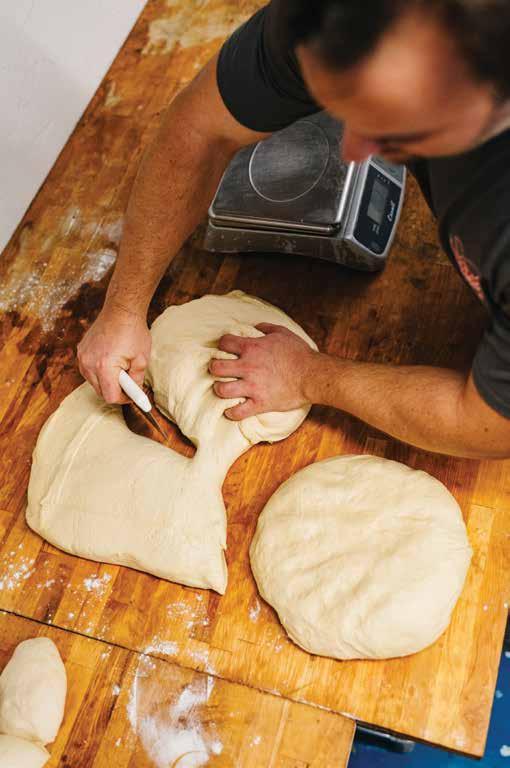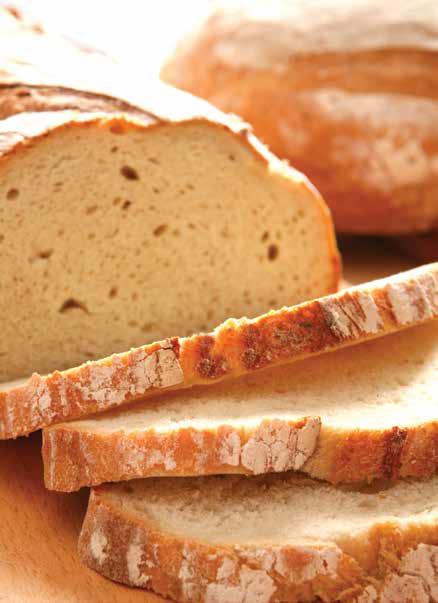
7 minute read
FOOD & BEVERAGE
Understanding the basics of breadmaking with Proof Bakery’s Dean Anderson
PHOTOS BY ELIZABETH NEAL STORY BY LEXI HOLIAN
Advertisement
For Good Measure
THERE’S PERHAPS NOTHING MORE COMFORTING than a fresh loaf of homemade bread – and while first-timers can be intimidated by the concept of baking, Proof Bakery’s Dean Anderson insists that there’s no reason to shy away from attempts to craft your own focaccia or a simple batch of white bread.
“You often hear the line that cooking is an art, and baking is a science,” he says while scoffing at the mythical quality routinely ascribed to baking. “But it’s all art and science. You can incorporate as much into cooking a burger as you can into making a praline mousse.”
The dedication really depends on the person – as demonstrated by Dean’s creations at Proof Bakery in Kill Devil Hills where he and an assistant bake
Previous page: Rolls fresh out of the oven at Proof Bakery. Right: A batch of tasty baguettes settle on some specially vented cooling racks (above); Precision is key when it comes to measuring out the dough (below).

hundreds of rolls and loaves of bread to be delivered to about 40 Outer Banks restaurants during the in-season.
As a professional baker, Dean has spent years fine-tuning his craft. He used to work 15-hour days, seven days a week to meet the demand for locally sourced fresh bread, producing upwards of 1,000 pounds of bread per day to meet the demands of nearly 60 restaurants. Today, he works with slightly fewer local eateries so he can spend more time fine-tuning the bread.
And when people interested in baking devote time to understanding the process, Dean believes that baking is easier than many think. “The most important things are patience and attention to detail,” he says, noting that new bakers in particular tend to worry when dough doesn’t rise quickly enough.
“Your yeast may have been sitting on the shelf for two years,” he adds. “Just be patient.”
Like many bakers, Dean was a chef before he ever decided to focus on bread. But after graduating from the Culinary Institute of America (CIA) and working at high-end restaurants in New York for years, he was looking for a new challenge when he began to see the allure of baking.
“Cooks always borrow techniques from the pastry world,” he explains. “And, to me, it seemed like all the new ideas were coming from pastry chefs.”
Whereas a savory chef’s recipe book might be disheveled, a pastry chef’s book is more likely to be immaculately constructed – and Dean is someone who appreciates that attention to detail…but he still maintains that procedure doesn’t classify bread-making solely as a science.
“I’ve made bread so many times that I don’t need to use a scale,” Dean says. “I do, because I want it to be perfect, Like many culinary but I don’t need to. I can eye it, and the dough will come out pretty much the professionals, he same – just like somebody’s gumbo or their risotto.” also likes to make More often than not, he thinks of bread recipes in percentages, whether small adjustments measured literally or visually. When combining flour, water, yeast and salt to his recipes until to make bread, he usually recommends about one percent of instant dry yeast they’re flawless.and one-and-a-half percent salt.
“After a while, you look at the recipes for your mousse, pastry cream or donuts, and you’re looking at percentages,” he says. “You understand that brioche should never go over 23-percent butter fat, because anything higher than that starts to ooze and becomes greasy. And you know that donuts are around four or five percent.”
Like many culinary professionals, he also likes to make small adjustments to his recipes until they’re flawless. When describing the baking process to friends, he might quote a CIA instructor and renowned chocolatier who adjusts ingredients in one-percent increments, making recipes 100 or 200 different times with slightly different measurements, changes in textures, or changes in agitation.
That’s a little more extreme than the way Dean operates. But when you put so much work into improving your craft, you can’t help but end up knowing the recipes inside and out.

continued on page 24
Baker extraordinaire Dean Anderson is in his element at Proof Bakery in Kill Devil Hills.

“When you make bread, you really want to be as perfect as possible from start to finish because the problems can compound,” Dean says good-naturedly. “But I find that to be true with anything.”
Luckily for home bakers, a mistake with a boule of dough will likely just lead to dense bread and more knowledge for a second attempt. In a professional bakery, leaving out an ingredient could mean throwing away 40 pounds of dough that were slated to become ciabatta, baguettes or brioche on a restaurant’s menu.
And when it comes to creativity, Dean finds his outlet in pastries, as well as special request breads from the restaurants served by Proof Bakery. Barefoot Bernie’s has a burger night during the off-season and has collaborated with Dean on buns such as corn onion rolls, croissant rolls and jalapeño cheddar rolls, while the Weeping Radish in Currituck orders pretzel triangles that sell both on and off the menu to customers who can’t get enough of them.
For those new to bread making, Dean recommends playing around with techniques like kneading to become familiar with how dough looks and feels. It can be difficult to tell the difference between under-kneaded and over-kneaded dough, for instance, because the two look very similar even though they feel completely different. To learn how much you should be kneading your dough, he offers a short experiment.
Take a batch of dough and divide it into three parts before you finish kneading. Knead one portion to the point where you think it’s just right. Knead the next one a little further until it’s tight and very smooth. Then knead the last one until you’re sure you’ve over-kneaded it. The different textures and consistencies will help you with future baking.
“It’s a good personal experiment,” he says cheerfully. “And, at the very least, you’ll get some great bread out of it.”
Bread for Beginners
Figuring out how to knead dough is just the beginning when it comes to making bread, but the overall process may be simpler than you think. If you’re baking bread for the first time, choose a basic recipe such as a loaf of white sandwich bread, French bread, focaccia or a rustic crusty bread. Many recipes also use a stand mixer with a dough hook, while others can be done with hand kneading or no-knead methods to achieve the right dough consistency. A stand mixer may seem like the easiest way to mix ingredients, but it’s also an easy way to end up with dough that’s too dense – so be sure to check the recommendations in your recipe. Hand kneading
is more work, but it may be the best way to achieve the
results you’re looking for, while a no-knead method will call for less yeast, and the dough will be slower to rise. Perhaps most importantly, take your time. Once you start mixing ingredients, measure carefully and go slow. You can always add more water (although you may need to proof your dough - i.e., let it rest and rise - for longer in order to alleviate tension), but ingredients such as yeast and salt simply can’t be added in later if you overlook them.
And don’t forget: The proof is in the baking!




Luxurious “Oceanfront Oasis”, in the most exclusive community on the Outer Banks, The Pine Island Reserve. A stunning investment property, new in 2016, with 2021 rental income projections approaching $505,000 over 27 weeks. Don’t miss capturing the fun of the first floor Atlantic City Boardwalk complete with arcade, theater, Surfboarder Bar that offers an open-air option to the poolside pavilion and swim-up bar. Relax or play in the massive pool area custom-designed for watersports, frolic in a separate shallow area with young ones, enjoy the blissful waterfall. Beautifully designed lighting carries you into the evening to enjoy the oceanside grotto - firepit, hot tub, and stargazing. Back inside, fun continues upstairs on the second floor with ocean and soundfront lounging inside and out highlighted by the Coffee Bar. The majority of the home’s 12 bedrooms are on this floor. The top level will astound you with the Ocean Room and its spectacular barrel-vaulted ceilings. Ocean to sound views! Celebrate at the Ship Bar, seating for 15. Enjoy delicious meals from a custom gourmet kitchen, exquisitely designed for preparing for family gatherings in the oceanfront dining room with seating for 16. Truly, a home for making memories for a lifetime. Invest. Enjoy. Relax.

Ray Meiggs Broker Associate

SCAN FOR COMPLETE LISTING









